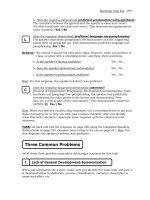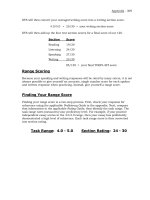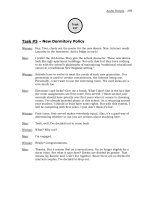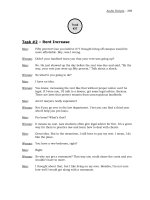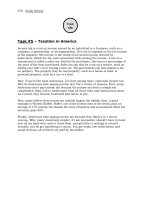Tài liệu Speaking and Writing Strategies for the TOEFL iBT part 22 ppt
Bạn đang xem bản rút gọn của tài liệu. Xem và tải ngay bản đầy đủ của tài liệu tại đây (302.14 KB, 10 trang )
Speaking Task One - 199
Make sure your contrarian response is a serious argument. Even if
you think that the prompt is asking the wrong question, you must
still demonstrate OPDUL=C
.
TASK: Using G+TiC=C or G+2TiC=C and the four steps, develop and deliver a basic
response that demonstrates OPDUL=C
for each of the following prompts you have
already studied (see the end of the chapter for a step-by-step guide). If you have
trouble, go back and look at the sample responses for help. Use a recording device
and check each response for coherence using the Independent Speaking Proficiency
Checklist on page 318. Rate each response using the Independent Speaking Rating
Guide on page 320.
Why do people travel? Develop your opinion using examples and reasons.
Should teenagers work during high school? Why? Give illustrations and
reasons to develop your argument.
Which technology in the past fifty years has changed your life the most?
Why? Develop your position using examples and reasons.
In your view, what was the greatest invention of the twentieth century?
Why? Give examples and reasons to support your argument.
These days people are living longer. Why? Develop your position using
examples and reasons.
Which person has been the greatest influence in your life? Give examples
and reasons to support and develop your opinion.
TASK: Using G+TiC=C or G+2TiC=C and the four steps, develop and deliver a
response for each of the following prompts. Use a recording device and check each
response for coherence using the Independent Speaking Proficiency Checklist on
page 318. Rate each response using the Independent Speaking Rating Guide on
page 320.
Many people leave their home country. Why? Give examples and reasons
to support your argument.
What is your idea of the perfect neighborhood? Support your position
with illustrations and reasons.
Remember!
Speaking Practice
1
2
3
4
5
6
More Speaking Practice
1
2
200 - Speaking Task One e
Why is the car important in daily life? Develop your response using
examples and reasons.
When is the best time to go on a vacation? Support your argument using
examples and reasons.
Why do some people never get married? Use examples and reasons to
develop your argument.
In this chapter, you learned how to develop, revise and deliver a variety of spoken
responses for single-question prompts using G+TiC=C
and the four steps. By doing
so, you can demonstrate OPDUL=C
in your response.
Test-takers who get high independent speaking scores have practiced
speaking a lot.
3
4
5
Remember!
Make a G+TiC=C note map; include transitions.
#1
Read the prompt.
#2
Develop ideas (15 seconds).
#3
Speak (45 seconds).
#4
What Have You Learned?
Speaking Task Two - 201
For this task, you will develop and verbally deliver a personal-opinion argument in
45 seconds. The task order follows.
For this task, you will answer a paired-choice prompt, for example:
Where have you seen paired-choice prompts before? The independent essay. In
fact, independent speaking task two (like independent Speaking Task #1) is really
just a mini independent essay. However, instead of developing your argument in
writing, you will develop it in 15 seconds, then deliver it verbally in 45 seconds.
How can you develop and deliver a mini, verbal independent essay in 60 seconds?
By using G+TiC=C
to demonstrate OPDUL=C.
Prompt Exercising reduces stress. Do you agree or disagree?
Develop your opinion using examples and reasons.
Speaking Task Two
Independent Task: Paired-Choice Prompt
Prompt Types
Task Time
3. Deliver your response.
45 seconds
1. Read the prompt.
2. Develop your response.
15 seconds
202 - Speaking Task Two o
When answering an agree-disagree prompt, speak subjectively using G+TiC=C and
follow the four steps to demonstrate OPDUL=C
in your response.
G = personally
TiC = for example
C = for those reasons
Organization
• deduction or induction
Progression
• general-specific or specific-general
Development
• introduction, body, conclusion
Unity
• topical and grammatical
Language Use
• word choice, idioms, sentence
variety
Delivery: fluency
automaticity
pronunciation
O
P
D
U
L
Coherent
Independent
Spoken
Response
C
Agree-Disagree Prompt: Step-by-Step
1.
Make a G+TiC=C note map; include transitions.
Step #1
Speaking Task Two - 203
The prompt will appear on your screen. A narrator will read it.
Avoid double arguments. Double arguments are identified by “or” or
“prefer” in paired-choice prompts. Choose one side of the argument
and develop it, for example:
Prompt: Do agree or disagree: We need zoos.
Double Argument: Sometimes I think that we need zoos, and sometimes
I think that we don’t need zoos.
Single Argument: Personally, I think that we don’t need zoos.
You only have 45 seconds speaking time. If you try to develop a
double argument, you will run out of time and not be able to develop
both arguments. This will result in a lack of topic development
(OPD
UL=C) and a lower score.
When the narrator stops speaking, a countdown clock will appear on your screen.
You will have 15 seconds to develop your response. The clock will count down (15,
14, 13 ). On your note map, jot down your opinion and one example. Remember
to use your own personal experience.
G = personally agree, need zoos
TiC = for example lions
C = in conclusion agree
Prompt We need zoos. Do you agree or disagree? Why? Give
examples and reasons to support your opinion.
Read the prompt.
Step #2
Warning!!
X
√
Develop ideas (15 seconds).
Step #3
Remember!
204 - Speaking Task Two o
When the countdown clock reaches zero, you will hear a “Beep!” Look at your note
map. It is your guide. Remember to speak subjectively.
Look at the following basic response.
To develop this basic response, add another body paragraph (G+2TiC=C).
Personally, I agree. I think that we need zoos.
For example, when I was 12, my teacher took us to the zoo in
Berlin. I had never seen wild animals before. I had just read
about them in books and seen them on the TV. But seeing
them in real life was amazing, especially the lions. On TV, they
looked so small, but seeing them alive they were really big. By
going to the zoo, I definitely saw things in a whole new light.
In sum, I think that we need zoos.
Personally, I agree. I think that we need zoos. Why?
For example, when I was 12, my teacher took us to the zoo in
Berlin. I had never seen wild animals before. I had just read
about them in books and seen them on the TV. But seeing
them in real life was amazing, especially the lions. On TV, they
looked so small, but seeing them alive they were really big. By
going to the zoo, I definitely saw things in a whole new light.
Now I have a family and we always go to the zoo every
summer. My wife makes a picnic and we spend all day there.
My kids love taking pictures and learning all about the animals,
especially the gorillas. Being outside is good for my children.
Best of all, they can leave the internet and the TV at home.
For those reasons, I think that we need zoos.
Speak (45 seconds).
Step #4
Speaking Task Two - 205
To develop this basic response into an advanced response, add a rhetorical why,
add a predictor thesis, then restate it in the conclusion.
Let’s map out another agree-disagree response using G+2TiC=C. Remember to
follow the four steps to demonstrate OPDUL=C
in your response.
G = personally
TiC = for example
TiC = next
C = for those reasons
From my point of view, I agree. I believe that we need zoos.
Why? Because zoos are educational and fun for families.
Zoos are educational. For example, when I was 12, my teacher
took us to the zoo in Berlin. I had never seen wild animals
before. I had just read about them in books and seen them on
the TV. But seeing them in real life was amazing, especially the
lions. On TV, they looked so small, but seeing them alive they
were really big. By going to the zoo, I definitely saw things in a
whole new light.
Zoos are also good for families. For example, now I have a
family and we always go to the zoo every summer. My wife
makes a picnic and we spend all day there. My kids love taking
pictures and learning all about the animals, especially the
gorillas. Being outside is good for my children. Best of all, they
can leave the internet and the TV at home.
For those reasons, I contend that we need zoos. Zoos are
educational and fun for families.
Words: 183
Agree-Disagree Prompt: Step-by-Step
2.
Make a G+TiC=C note map; include transitions.
Step #1
206 - Speaking Task Two o
When the narrator stops speaking, a countdown clock will appear on your screen.
You will have 15 seconds to develop your response. The clock will count down (15,
14, 13 ). On your note map, jot down ideas.
When the countdown clock reaches zero, you will hear a “Beep!” Look at your note
map. It is your guide. Start speaking.
Prompt Exercising reduces stress. Do you agree or disagree?
Develop your opinion using examples and reasons.
G = personally agree
TiC = for example me
TiC = next girlfriend
C = in sum agree
The prompt asks whether exercising reduces stress or not.
Personally, I posit that exercising does reduce stress. Why?
For these reasons.
First, after class I run up and down a big hill near my
university. The distance is ten miles. It is definitely hard work,
but I love it. If I don’t run every day, I have a hard time
sleeping. After I run, I feel stress free. Best of all, I sleep like
a log.
Next is my girlfriend. She loves to exercise too. After a hard
day of work, she hits the gym near our house and does yoga
and pilates. She says it is a great way to relieve the pressures
of being a new lawyer in a big law firm.
In sum, exercising definitely reduces stress. If you want to
stay happy and healthy, you should exercise every day.
Words: 143
Read the prompt.
Step #2
Develop ideas (15 seconds).
Step #3
Speak (45 seconds).
Step #4
Speaking Task Two - 207
Mapped out, you can see how G+2TiC=C gives the speaking raters what they are
trained to look for: a coherent spoken response that demonstrates OPDUL=C
.
Note
: Transitions (T) are in bold, the supporting illustration (i) in italics, the
opinion (G) and the conclusions (C) underlined
.
G = general = The prompt asks whether exercising reduces stress
or not. Personally, I posit that exercising does
reduce stress. Why? For these reasons.
TiC = specific = First, after class I run up and down a big hill near
my university. The distance is ten miles. It is
definitely hard work, but I love it. If I don’t run every
day, I have a hard time sleeping. After I run, I feel
stress free. Best of all, I sleep like a log
.
TiC = specific = Next is my girlfriend. She loves to exercise too. After
a hard day of work, she hits the gym near our house
and does yoga and pilates. She says it is a great way
to relieve the pressures of being a new lawyer in a big
law firm.
C = general = In sum, exercising definitely reduces stress. If you
want to stay happy and healthy, you should exercise
every day.
TASK: Check this response for coherence using the Independent Speaking
Proficiency Checklist on page 318. Rate it using the Independent Speaking Rating
Guide on page 320. Compare your rating to the one on page 341. Note
: For this
response, the speaker’s delivery was proficient.
When answering a support-don’t support prompt, use G+TiC=C and the four steps
to demonstrate OPDUL=C
in your response.
Prompt A big airport will be built near your hometown. Do
you or don’t you support the new airport? Develop
your argument using examples and reasons.
Support-Don’t Support Prompt: Step-by-Step
Make a G+TiC=C note map; include transitions.
Step #1
Read the prompt.
Step #2
208 - Speaking Task Two o
TASK: Check this response for coherence using the Independent Speaking
Proficiency Checklist on page 318. Rate it using the Independent Speaking Rating
Guide on page 320. Compare your rating to the one on page 341. Note
: For this
response, the speaker’s delivery was proficient.
By using G+TiC=C or G+2TiC=C, your response will demonstrate a variety of
rhetorical strategies. Rhetorical strategies demonstrate topic development
(OPD
UL=C) and proficient language use (OPDUL=C). Topic development and
proficient language use = greater coherence (OPDUL=C
) = a higher score.
From my perspective, I support a new airport near my
hometown. Why? Because we need jobs.
I live in Osnabrueck, Germany. Osnabrueck is a small city with
many tourist attractions. The businesses we have, however,
are small and don’t offer many jobs to young people, so the
young people always move away to big cities like Berlin and
Frankfurt. But if we got a new airport, we could have many
jobs for young people. If they got jobs, they could stay and
help develop the economy of Osnabrueck. Also, the airport will
attract other new businesses, and that is good for creating jobs
too.
For the aforementioned reasons, I support the new airport. A
new airport will be good for Osnabrueck. If we don’t accept it,
some other town will and Osnabrueck will lose jobs and young
people.
Words: 138
G = from my perspective support
TiC = example jobs
C = for the aforementioned reasons - support
Develop ideas (15 seconds).
Step #3
Speak (45 seconds).
Step #4
Rhetorical Strategies
